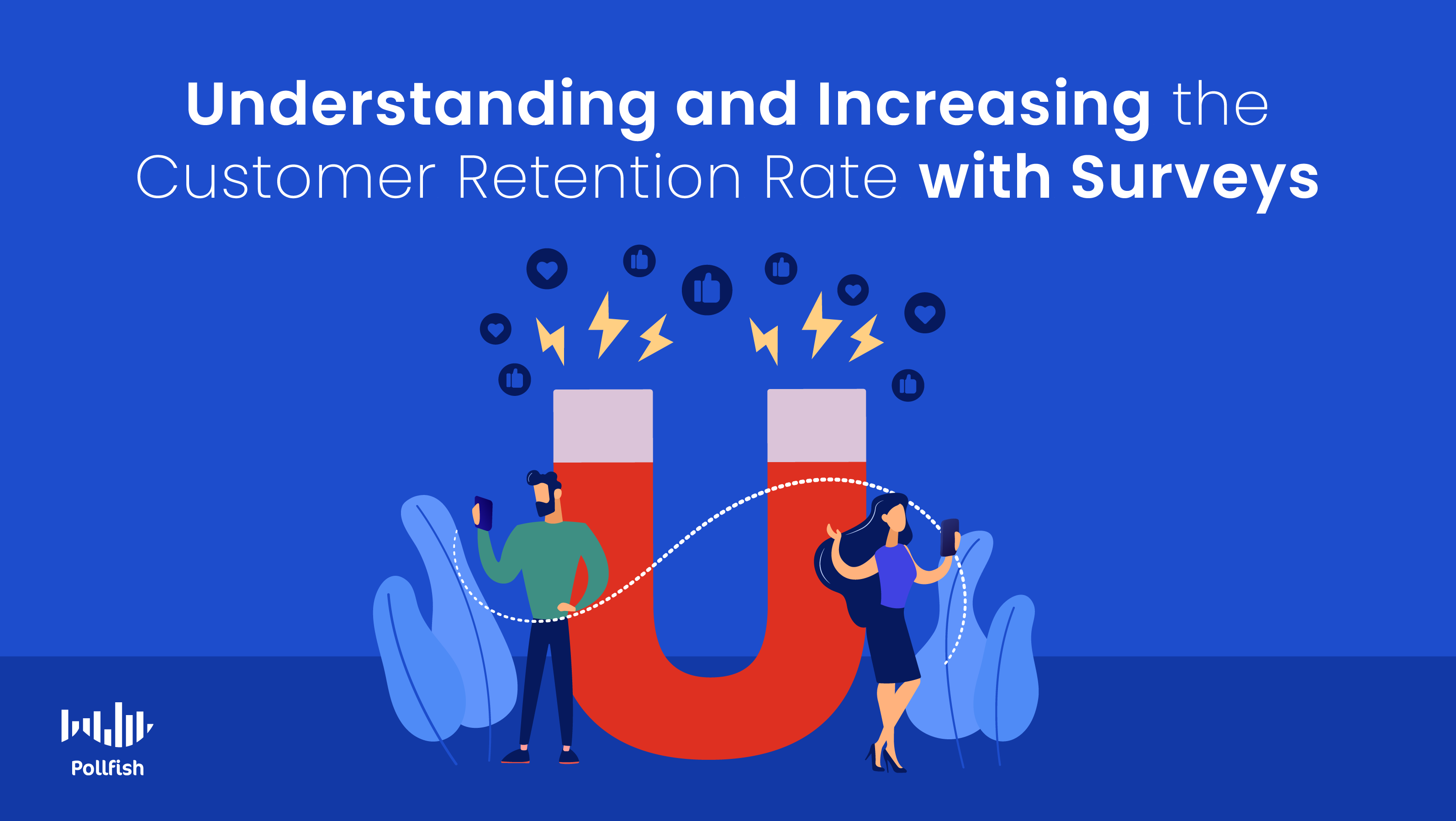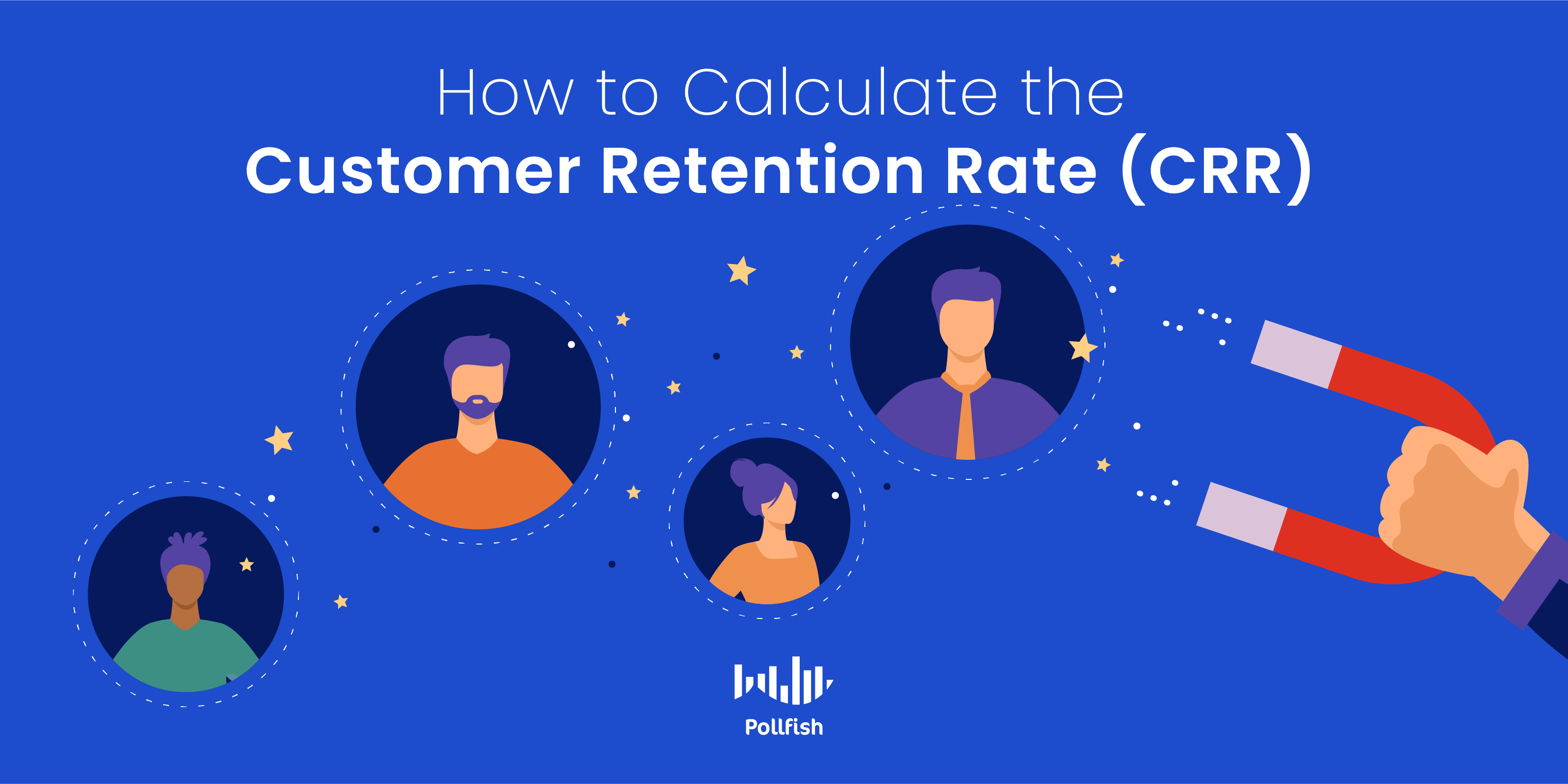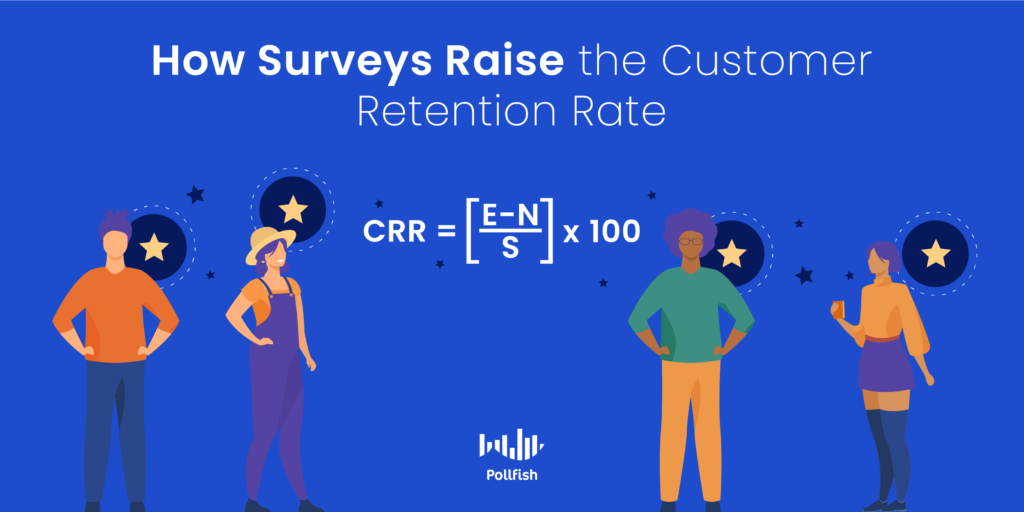Increasing the Customer Retention Rate with Surveys

The customer retention rate (CRR) is a crucial metric for virtually all industries. As its name suggests, it measures the percentage of customers that a business has retained over a given period of time.
This rate essentially spells out how successful companies are at satisfying and keeping their existing customers. It is therefore a measure of customer loyalty, helping businesses better understand why customers stay with a company.
In turn, businesses can improve their offerings and experiences to increase their customer retention. Retention is a key business concept to uphold, as increasing customer retention by just 5% can increase company revenue by 25-95%.
This article explains the customer retention rate, how to calculate it, its importance, the CRR across industries, and how surveys help increase it.
Understanding the Customer Retention Rate
Customer retention rate (CRR) is a metric that measures a company’s ability to retain its customers over time. A percentage-based metric, it measures how many customers a business retains at the end of a given time period.
For example, if a business has 100 customers at the beginning of the year and has 70 at the end of the year, its retention rate is 70%. (See the section on its calculator for the breakdown of its formula).
This rate is the opposite of churn rate, which gauges the percentage of customers that a business loses over a period of time.
The importance of the customer retention rate will vary based on its industry. For example, businesses that provide subscription-based services (from B2B SaaS to B2C magazine subscriptions) depend on higher customer retention, as it directly affects the profitability of the business.
However, a high customer retention rate is still crucial for all sorts of businesses, as existing customers are 31% more likely to spend more on their average order than new customers. Additionally, retained customers are 51% more likely to try a business’s new offerings.
Thus, maintaining a high customer retention rate should be a top business priority. This involves going beyond measuring the rate alone, but establishing customer satisfaction.
The Importance of the Customer Retention Rate
This metric is important to calculate, keep track of and most importantly, use to raise customer retention. It provides a simple data point for determining how many customers a business retains over time.
It also carries considerable weight in other business matters.
Firstly, studying this rate is important given that it is a major KPI, but unlike many KPIs, this metric relays one of the most sought-after aspects for a business, that of customer retention, as its name implies.
Customer retention, as explained above with statistical figures, offers a wealth of benefits. These include those of relationship-building with customers, forging loyalty and gaining more profits.
Another such benefit is the affordability factor. Given that customer retention is far more valuable for a business than acquisition, one would think it is more expensive to achieve. However, it is anywhere from five to 25 times cheaper to retain an existing customer than it is to acquire a new one. Thus, it is financially more practical and viable to implement customer retention methods.
In order to form such methods, a business must know its standing when it comes to its customer retention, and that is the exact data point that this rate provides.
Additionally, studying this rate, businesses can increase customer lifetime value (CLV), which relays the total monetary value a customer brings to a business throughout the entirety of their relationship with the business. This helps businesses understand which customers and customer segments are the most useful for their business.
By studying your customer retention rate, businesses can improve their ROI and grow revenue, as retaining customers, as laid out in the above figures, is healthy and profitable for businesses. When customers trust a business with their patronage, they provide value, be it with regular purchases or online interactions, such as with social media posts and contributing their own positive reviews.
How to Calculate the Customer Retention Rate

There are several formulas to calculate customer retention rate or CRR, but businesses only need to choose one to narrow down their retention rate. One of the most commonly used formulas uses the following variables and equations:
CRR Variables:
EC – number of customers at the end of a given period
NC – number of new customers during that period
SC – number of customers at the start of that period
Customer Retention Rate Formula
CRR = ((EC-NC)/SC) x 100,
CRR Formula Example:
Let’s assume that a business released a new product. At the beginning of Q1, it had 1,200 customers and at the end of Q1, it had 1,400 customers, having acquired 300 new customers within Q1. The CRR is thus calculated as:
CRR= ((1,400- 300) / 1,200)) x 100
CRR= ((1,100) / 1,200)) x 100
CRR= 0.91666 x 100
CRR= 91.67%
Although this is a strong CRR, businesses should remember that it also signifies a percentage of customers lost (normal in business). In this case, the business lost close to 100 customers.
The Customer Retention Rate Across Industries
The average customer retention rate varies across industries. As such, there is no hard and fast rule designating a good or bad rate.
A 100% retention rate is a patently good rate, as it is the highest possible one. Meanwhile, a rate closer to 0%, such as 20%, can objectively be determined as poor. Percentages that run in between these numbers will have different attitudes towards acceptability across industries.
What may work for one industry or niche may be deemed poor for another, and vice versa.
The following provides a rundown of the average customer retention rate across industries:
- Retail: 63%
- Telecom: 75%
- Banking: 78%
- IT Services: 81%
- Insurance: 83%
- Professional services: 84%
- Media: 84%
How Surveys Can Increase Customer Retention Rate

Surveys, especially the online variety, provide a quick and practical means of conducting primary research. While market research techniques include a host of other primary and secondary research techniques, surveys are by every measure, the most proper tools for not simply conducting market research, but to be used as vehicles for increasing the CRR.
Although conducting secondary research is a useful practice, secondary sources do not address specific topics, issues and least of all, inquiries that businesses have about their subjects. Therefore, conducting secondary research alone is insufficient for market research, let alone increasing the CRR.
Companies must incorporate primary research into their market research campaigns, as this method allows businesses to scope out their particular topics and most importantly, their own target market.
To reiterate, survey research is the solution for virtually any market research campaign. Surveys open up the minds of customers’ to market researchers and their respective businesses.
As such, when survey research is carefully conducted and on a potent online survey platform, researchers gain a wealth of customer insights, the kinds that help brands improve their customer experience and overall standing in the eyes of their customers.
When businesses understand their customers on an in-depth level, they can thereby market to and serve them more effectively. Customers appreciate when brands understand their unique grievances and needs, along with the marketing personalization efforts used to better cater to them.
When businesses develop strong relationships with their customers, they build and reinforce customer loyalty, a major component of customer retention. But businesses can only build these kinds of relationships when they understand their customers on a deeper level.
Surveys provide a feasible solution for reaching these kinds of customer insights, allowing businesses to better understand and serve their customers, therefore raising the customer retention rate.
Making Strides in Retaining Customers
A high customer retention rate is an integral ingredient for business success. Businesses must prioritize their CRR over customer acquisition, as customer retention is more beneficial and practical for businesses.
Survey research, as explained above, helps increase the customer retention rate; however, not all surveys are viable for this pursuit. Businesses must choose their online survey platform wisely, in order to ensure they are extracting optimal data and using an agile platform.
A strong online survey platform uses the random device engagement sampling method (RDE) to ensure randomization and obtain respondents in their natural digital environments, along with AI and machine learning for data quality checks, a vast system of survey employment and more. The Pollfish platform offers all of these abilities and far more.
Pollfish Marketing Team
Ready to Try Pollfish?
Create your survey with AI, target high-quality respondents starting at $0.95 per complete, and start getting results in just minutes in real-time. From running a simple product concept survey to managing a constant stream of trackers for dozens of clients in dozens of countries, we’ve got you.
